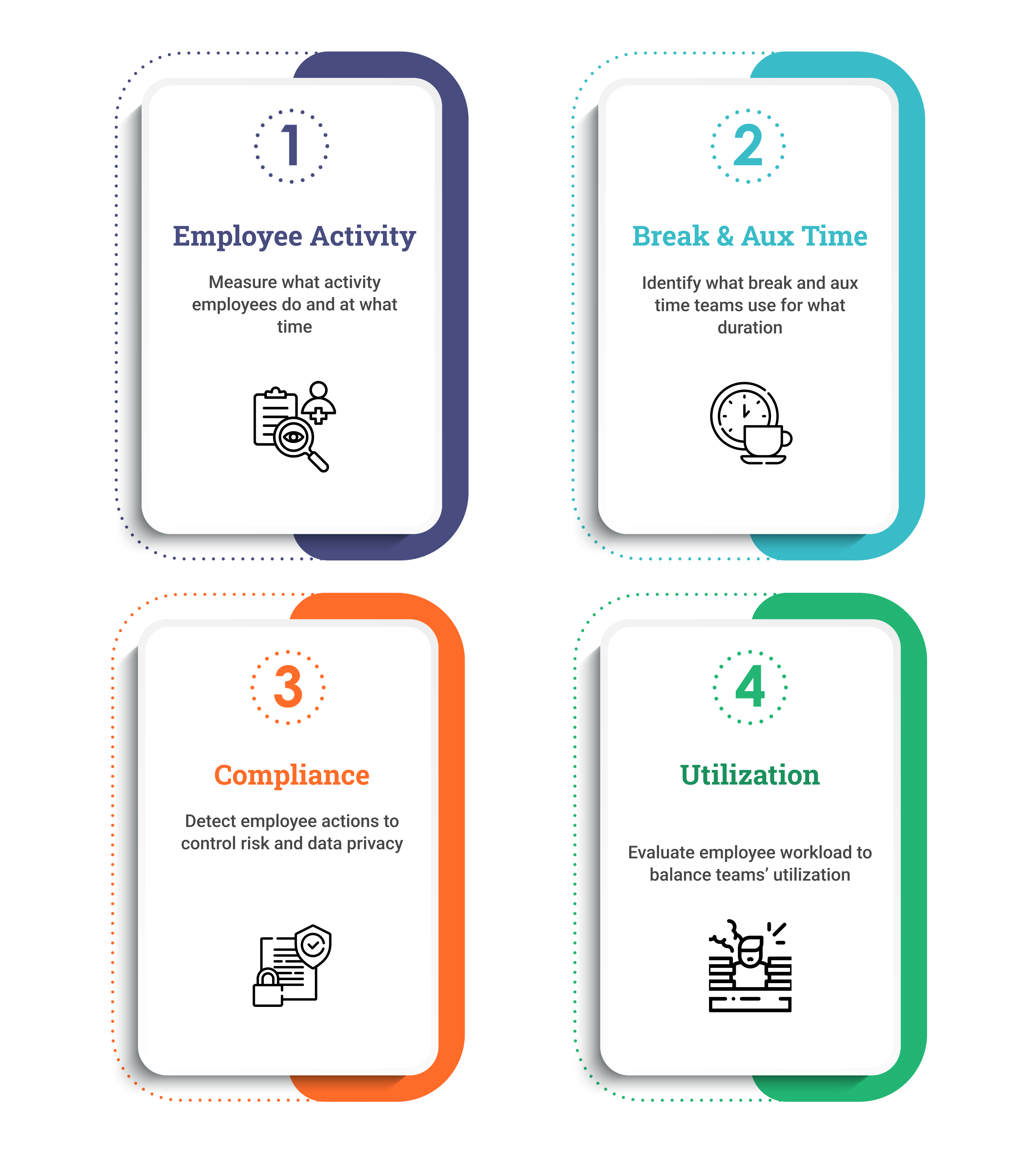Employee work location contributes significantly to how teams perform and with what productivity. The recent three work environments in practice, including office, remote, and hybrid have their impact on employee performance, and each influences employees at work differently, with one encouraging collaboration while the other promoting work flexibility.
Table of Contents
Let us understand how different work environments impact employee performance and pose productivity challenges:
Impact of work environment on employee performance
The surroundings in which employees work define how they will perform and what productivity they will achieve. Balancing the merits and demerits of the workplace is key to efficient employee performance. Let us discuss the role of workplaces in defining employee productivity.
Office work environment – Better team collaboration
Office as a workplace provides better team collaboration with employees working next to each other and are easily available to discuss work, plan strategies, or brainstorm ideas. You can get help fast, seek advice, and casually conversate with office water cooler talks to shed off work monotony and reset productivity. With these advantages, office settings are not immune to inefficiencies at work, let us discuss what causes that:
Productivity challenges in office work
Productivity challenges in office work can diminish its collaboration advantage and cost employees with low focused time and inefficiency at work.
– More casual conversations: Office employees working together and in front of each other get prompted to have casual conversations and this practice is frequent in the office environment that majorly impacts employee productive hours.
– Frequent check-ins: With employees working in front of the managers, it can lead to managers frequently checking in with teams which impacts employee engagement at work.
– Reduced work flexibility: Office employees work under close supervision of management which affects their work flexibility and makes them continue work with fewer breaks.
– Less focused time: The office environment with more commute time, casual conversations, and frequent check-ins limits focused time and impacts productive work.
– Low efficiency at work: Less focused time in office work leads to employee inefficiency and non-productivity.
How to overcome productivity challenges in office work
It is important to balance the work environment in office settings to control inefficiency and encourage employees for more productive work.
– Control casual conversations: Detect multiple persons around the workplace to alert them and control frequent casual conversations among office employees.
– Measure employee work hours: Identify what hours employees work and what employee productive hours are to measure work efficiency.
– Alert employees for breaks: Find out what employees work for continuous hours to alert them for breaks and avoid employee burnout.
– No frequent check-ins: Measure employee activities at work with an intuitive dashboard to negate frequent employee check-ins and save employee time.
– App and web usage: Detect what applications and websites employees visit and what helps them in work to boost focused time and control non-productive app and web usage.
Remote work environment – Flexible workspace
The current shift toward future work is encouraging more organizations to adopt remote work and employ more global talents for standardized and productive work. Distributed teams working in remote environments can leverage more focused time resulting in increased work efficiency. Though an unmonitored remote work environment can drive non-productivity at work, let us explore what leads to that.
Productivity challenges in remote work
Distractions in remote work can lead to employee disengagement and low motivation to perform, let us discuss more.
– Inefficient performance:
Remote employees working in flexible work environments can easily get distracted by home or other remote workplace surroundings which can cause inefficient work performance and more non-productive hours.
– Non-compliant actions: Distributed work poses the challenge of knowing employee actions and you cannot know how compliant employee activities are, which can risk data privacy at work and breach business policy.
– Work inefficiency: The more flexible remote work environment can prompt distributed teams not to optimize their work hours which can cause work inefficiencies and project delays at work.
– Low work engagement: Distractions in remote work including unorganized workspace and less focused time can cause low employee engagement at work which can lead to low employee productivity and performance.
– Less productive hours: Unmonitored remote teams can take frequent breaks, that too, for exceeding duration, and can spend more idle time which can impact their work hours and productivity in distributed work.
How to overcome productivity challenges in remote work

Read More : Workplace Productivity Challenges and How to Overcome Them
Controlling inefficiency in distributed work, organizations with remote teams can encourage more productive work, let us further explore.
– Know employee activities: Find out when your remote teams log into work, what time they spend being active at work, when they are idle, and when they log out to measure how employees spend the day in distributed work.
– Measure break and aux time: Identify when your remote workforce uses break time and if they exceed it, or when your BPO or contact center teams take aux time, for what purpose, and duration to learn how it impacts employee work efficiency.
– Ensure compliance at work: Detect employee actions in remote work environments, especially in BPOs and contact centers, and learn how they behave, whether their actions are compliant with business policy and data privacy, and whether they cause risk to ensure clean desk compliance in remote work environments.
– Identify employee utilization: Know the workload of distributed employees and learn what their utilization ratios are. Learn what employees are over, under, or adequately utilized to find the employee work bandwidth and distribute work to balance employee workload.
– Analyze employee engagement at work: Measure factors that affect employee engagement in remote work including employee workload and continuous work hours by measuring employee utilization and work time to avoid burnout and encourage more focused and productive work.
Hybrid work environment – Combination of work flexibility and team collaboration
The combination of remote and office work, the hybrid environment provides a balance between in-person collaboration for teams working in the office and flexibility for the teams working remotely. With teams switching to office and remote work, hybrid work presents the challenge of managing work hours and productivity for remote and office teams.
Productivity challenges in hybrid work
Inefficiency, less productive hours, and low employee performance are the common challenges in hybrid work, let us discover more.
– Manage hybrid teams: Depending on the need, hybrid teams may work part of the day in the office and the rest part of the day remotely which makes it tricky to manage employee work hours and productivity.
– Manage time for remote and office teams: With hybrid teams working distributed in remote and office environments, it gets tough to measure what teams spend what time on what tasks, and what are their work efficiency.
– Measure productivity for hybrid teams: Estimating the time that hybrid teams spend on tasks is complex which makes it tricky to measure their productive hours.
How to overcome productivity challenges in hybrid work
Analyzing the performance of Hybrid teams working in remote and office environments helps measure their performance.
– Hybrid work analytics: Measure what teams work in the office and what teams work in remote environments to know how and where hybrid teams work.
Read More : Employee Monitoring in the Modern Workplace
– Attendance analytics for hybrid teams: Analyze what hybrid teams log into remote and office work environments and what their availability is in hybrid work to allocate tasks.
– Work from home vs work from office: Identify productive hours for remote and office working hybrid teams with their work hours and efficiency.
– Daily logged-in vs not logged-in: Detect what teams log into work and what teams do not for each workday and find out workforce availability in hybrid work.
Why do you need employee monitoring software to manage distributed teams
Manage your in-office, remote, and hybrid teams with effective employee monitoring software to measure where they work and what tasks they perform with what productivity and efficiency. Start a free trial to get firsthand experience of how a productivity monitoring tool can maintain performance for your distributed teams.
What are the factors affecting employee productivity?
Different work environments impact employee productivity as office work minimizes work flexibility due to teams working under close supervision of management, while remote work risks employee productivity with employees working in an unmonitored work environment, and hybrid work affects employee efficiency with teams switching to office and remote teams struggle to focus on work.
Why is the location factor important to boost employee performance?
Work locations can drive or disrupt employee performance. Balancing efficiency and productivity in different work environments helps improve employee performance, like allowing more flexibility in office work, measuring employee productivity in remote work, and controlling efficiency in hybrid work maximizes employee performance in diverse work environments.
What is the benefit of employee monitoring for remote teams?
Monitoring remote teams helps measure what teams work on what tasks and with what efficiency to find inefficiency at work and boost employee performance.
Why does monitoring hybrid teams help improve employee efficiency?
Analyzing office and remote teams in hybrid work gets you real-time data about teams working in what environment and doing what tasks at what time to measure employee efficiency in the hybrid environment.
wAnywhere Blog
Check out the wAnywhere blog to learn more about our product, customer stories, and our take on meetings, remote working, productivity, and more.

